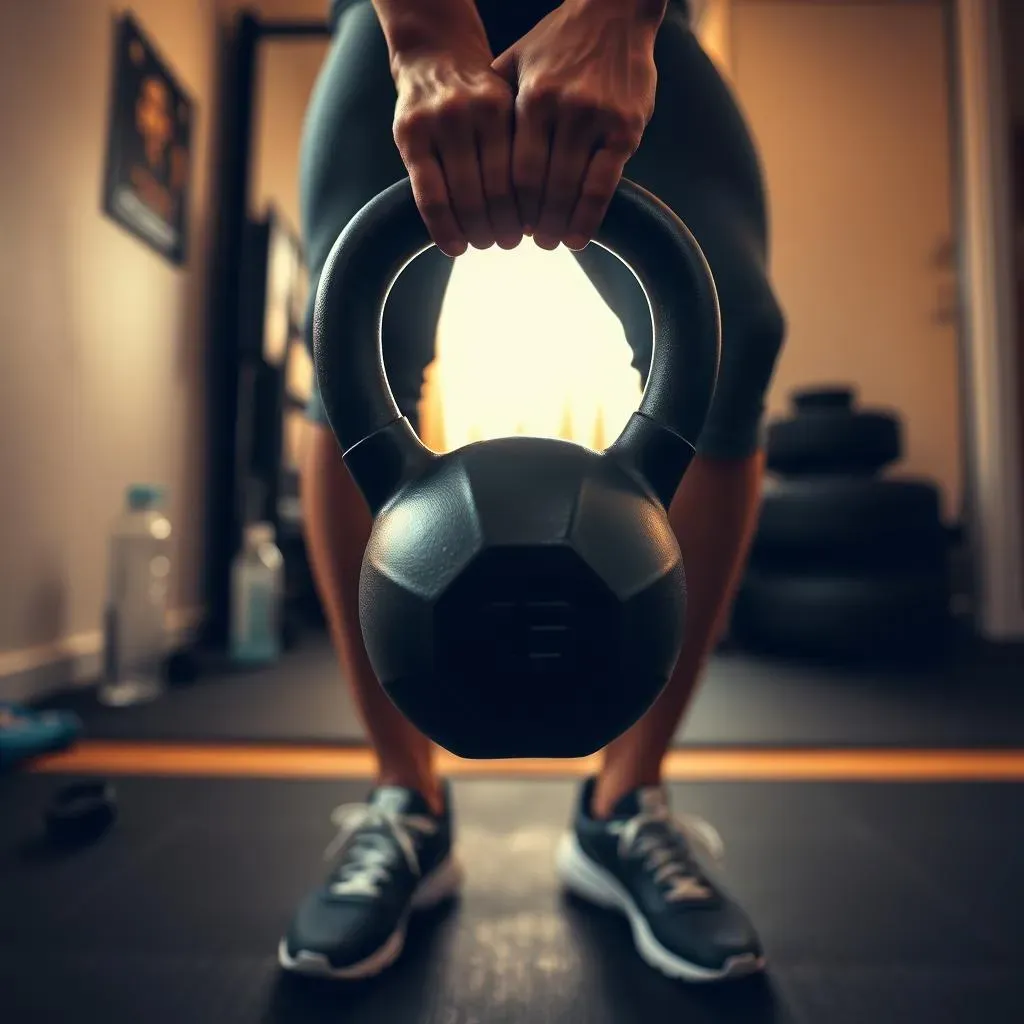Table of Contents
Short on time but big on fitness goals? Then you've come to the right place! This article is your ultimate guide to a killer 10-minute beginner kettlebell workout. We'll walk you through everything you need to know, from picking the right kettlebell weight and setting up your workout space, to mastering simple yet effective exercises that will challenge your entire body. Forget those lengthy, boring workouts; this 10-minute routine packs a serious punch. We'll show you how to build a full-body strength routine that's perfect for beginners, and we'll offer tips on how to progress your workouts as you get stronger. We'll even cover important safety considerations to help you avoid common mistakes and injuries. Ready to transform your fitness routine in just 10 minutes a day? Let's get started with this 10 minute beginner kettlebell workout!
Getting Started: Choosing Your Kettlebell and Setting Up

Getting Started: Choosing Your Kettlebell and Setting Up
Picking the Perfect Kettlebell
So, you're ready to start your 10-minute kettlebell workout journey? Awesome! First things first: choosing the right kettlebell. Don't get overwhelmed; it's simpler than you think. For beginners, a lighter kettlebell (8-12 lbs for women, 12-15 lbs for men) is ideal. Think of it like this: you want a weight that challenges you but doesn't make you want to throw the kettlebell across the room (we've all been there!). You should be able to comfortably complete the exercises with good form. If you're unsure, start with a lighter weight and gradually increase it as you get stronger. Remember, proper form is key – a heavier kettlebell with poor form is less effective and more likely to cause injury. Check out our guide on beginner kettlebell programs for more tips.
Many beginners find adjustable kettlebells super handy. These let you change the weight as you progress, saving you money in the long run. However, if you are sure you will continue working out, a fixed weight kettlebell can be more stable and easier to use. No matter what you choose, make sure it feels comfortable in your hand. A good grip is essential for safety and proper form. Don't be afraid to experiment and find what works best for you. Remember to check out our other articles on best beginner kettlebell workouts to find the right fit for your fitness level.
Weight Range | Recommended for |
|---|---|
8-12 lbs | Beginner women |
12-15 lbs | Beginner men |
Adjustable | All levels |
Setting the Stage for Success
Next up: setting up your workout space. You don't need a fancy gym; a small, clear area in your living room, bedroom, or even your backyard will do the trick. Ensure you have enough space to move freely without bumping into furniture or walls. A non-slippery floor is crucial to avoid accidents. Consider using a mat or towel for extra grip and comfort. Having a timer handy will also help you keep track of your workout intervals. A simple kitchen timer or a phone app will work perfectly. Before you start your routine, it's always a good idea to do some light warm-up exercises like arm circles and leg swings. This will help prepare your muscles and prevent injuries. Also, make sure you have a water bottle nearby to stay hydrated throughout your workout. Remember, preparation is half the battle! Once you're all set, you're ready to embark on your 10-minute kettlebell adventure. For some extra core work, check out our article on kettlebell core workouts for beginners.
Finally, put on some upbeat music! A good playlist can really boost your motivation. Think of your workout space as your personal sanctuary – a place where you can focus on yourself and your fitness goals. Make it a space you enjoy being in. Remember that consistency is key, so make sure your workout space is easy to access and inviting. The more convenient it is to work out, the more likely you are to stick to your routine. Consider what makes you feel energized and motivated, and create a space that reflects that. Ready to start? We've got a great beginner kettlebell workout just waiting for you!
- Clear space
- Non-slippery floor
- Timer
- Water bottle
- Upbeat music
The Workout: Simple Exercises for Maximum Impact

The Workout: Simple Exercises for Maximum Impact
Kettlebell Swings: The Foundation of Your Workout
Let's start with the king of kettlebell exercises: the swing. It's deceptively simple, but it works wonders for your entire body. Think of it as a full-body power move that strengthens your posterior chain (glutes, hamstrings, back) while also engaging your core. Hold the kettlebell with both hands, hinge at your hips (think of pushing your butt back), and swing the kettlebell between your legs and up to chest height, keeping your back straight and core engaged. Focus on using your hips to generate power, not your arms. Aim for 10-12 repetitions, and remember to breathe! For a more detailed guide, check out our post on beginner kettlebell workouts. Don't worry if it feels awkward at first – it takes practice! We all started somewhere.
A common mistake is using your arms to lift the kettlebell. Remember, the power comes from your hips and legs! Imagine you're throwing a medicine ball, but with controlled power. If you find yourself struggling, try reducing the weight or breaking down the movement into smaller parts. For example, practice the hip hinge movement separately before adding the swing. Remember, it's all about building a strong foundation. Consistency is key – even a few swings a day are better than nothing! You can find more advanced kettlebell exercises in our ultimate guide to kettlebell exercises.
- Focus on hip movement
- Keep your back straight
- Control the weight
- Breathe properly
Goblet Squats and Kettlebell Rows: Building Strength and Stability
Next up, we've got two more exercises to sculpt your legs and upper body. Goblet squats are fantastic for building leg strength and improving balance. Hold the kettlebell close to your chest, like a goblet, and squat down as if sitting in a chair, keeping your back straight and core engaged. Aim for 10-12 repetitions. These are great for strengthening your quads, glutes, and hamstrings – the powerhouses of your lower body. For variations, check out our full body kettlebell workout for beginners.
Now, let’s target your back and biceps with kettlebell rows. Hold the kettlebell in one hand, and let your body hinge at the hips. Keeping your back straight, pull the kettlebell up towards your chest, squeezing your shoulder blades together. Lower the weight slowly and repeat for 10-12 repetitions on each side. This exercise will build strength and improve your posture. Remember to maintain a stable core throughout the movement. For more exercises to build core strength, you can check out our 4 kettlebell exercises for core strength. Remember to focus on controlled movements and maintain proper form throughout.
Exercise | Muscle Group | Reps |
|---|---|---|
Goblet Squat | Legs, Glutes, Core | 10-12 |
Kettlebell Row | Back, Biceps, Core | 10-12 per side |
Beyond the 10 Minutes: Building Your Kettlebell Routine

Beyond the 10 Minutes: Building Your Kettlebell Routine
Gradually Increasing Intensity
So, you've conquered your first 10-minute kettlebell workout? Fantastic! Now it's time to think about how to keep challenging yourself. The key here is gradual progression. Don't jump to a heavier kettlebell immediately; that's a recipe for injury. Instead, focus on increasing the number of repetitions you do for each exercise. Once you can comfortably complete 12-15 reps with good form, you can consider increasing the weight slightly. Even small increases can make a big difference over time. Remember, consistency is key, and listening to your body is even more important. Pushing yourself too hard too soon can lead to burnout and injury. Check out our beginner kettlebell program for a structured approach to progression.
Another way to increase intensity is to reduce rest time between sets. Start by shortening your rest periods by 15 seconds each workout. As you get fitter, you can reduce them further. This will increase your cardiovascular fitness and help you build endurance. You can also experiment with different variations of the exercises we've covered. For example, you can try single-arm kettlebell rows for a greater challenge. You could also try adding a jump to your squats. The possibilities are endless! If you're looking for more intense workouts, consider a kettlebell HIIT workout once you’ve built a solid foundation.
- Increase reps
- Increase weight gradually
- Reduce rest time
- Try exercise variations
Adding New Exercises and Expanding Your Routine
Once you're comfortable with the basic exercises, it's time to expand your routine. There's a whole world of kettlebell exercises out there, each targeting different muscle groups. Start by researching new exercises one at a time. Don't try to learn everything at once; focus on mastering a few new moves before adding more. Start with exercises that build upon what you've already learned. For example, once you're comfortable with the kettlebell swing, you could try Turkish get-ups or clean and press. Remember to prioritize proper form over speed or weight. If you're unsure about proper form, it's always best to consult a qualified fitness professional or watch instructional videos. You can find many helpful resources online, and we also have a pdf guide to kettlebell exercises to help you out!
As you add new exercises, consider creating a weekly workout schedule. This will help you stay organized and track your progress. A sample schedule could be three days of kettlebell workouts, each focusing on different muscle groups, with rest days in between. Remember to listen to your body and take rest days when needed. Don't be afraid to experiment and find a schedule that works for you. The most important thing is to find a routine that you enjoy and can stick with. Remember, consistency is more important than intensity. If you're looking for more structured routines, consider checking out our best kettlebell workouts for beginners.
Day | Focus | Exercises |
|---|---|---|
Monday | Lower Body | Goblet Squats, Kettlebell Swings |
Wednesday | Upper Body | Kettlebell Rows, Kettlebell Presses |
Friday | Full Body | Kettlebell Swings, Goblet Squats, Kettlebell Rows |
Safety First: Avoiding Common Mistakes and Injuries

Safety First: Avoiding Common Mistakes and Injuries
Mastering Proper Form: The Key to Injury Prevention
Let's talk about proper form – it's not just about looking good; it's about preventing injuries. Think of your body as a finely tuned machine; if you use it incorrectly, things will break down. With kettlebell exercises, proper form is paramount. Watch instructional videos, and if possible, work with a trainer initially to ensure you're performing each movement correctly. Don't rush into heavier weights before mastering the technique. Start with lighter weights and focus on smooth, controlled movements. If you feel any pain, stop immediately. Pain is your body's way of saying "STOP!" Remember, consistency with good form is far more effective than intense workouts with bad form. For more tips on form, check out our guide on beginner kettlebell workouts.
A common mistake is rounding your back during exercises like kettlebell swings and rows. This puts immense strain on your spine and can lead to serious injury. Always keep your back straight, engaging your core muscles to support your spine. Imagine someone is about to gently push you from behind - that's the level of core engagement you should aim for. Another frequent problem is using momentum instead of controlled movements. While momentum is a part of some exercises like the swing, you should avoid relying on it excessively. Focus on controlled movements throughout each repetition. This will help build strength and prevent injury. For a more comprehensive guide to kettlebell safety, consider checking our ultimate guide to kettlebell exercises (PDF).
- Watch instructional videos
- Start with lighter weights
- Keep your back straight
- Use controlled movements
Listen to Your Body: Rest and Recovery
Your body needs time to recover, especially when you're starting a new workout routine. Don't push yourself too hard, too soon. Listen to your body's signals. If you feel pain, stop and rest. Muscle soreness is normal, but sharp or intense pain is not. Rest days are just as important as workout days. They allow your muscles to repair and rebuild, making you stronger and preventing injury. Aim for at least one or two rest days per week, depending on your fitness level and how your body feels. During your rest days, you can still engage in light activities like walking or stretching. This will help maintain blood flow and flexibility. Remember, consistency is key, but so is rest. For more information on recovery, check our beginner kettlebell program.
Don't be afraid to take extra rest days if you need them. It's better to miss a workout or two than to risk injury that could sideline you for weeks or even months. Your body is your temple; treat it with respect. Adequate sleep is also crucial for muscle recovery. Aim for 7-9 hours of quality sleep each night. This will help your body repair itself and prepare for your next workout. Remember, this is a marathon, not a sprint. Sustainable fitness is about finding a balance between training and recovery. If you're struggling with recovery, consider incorporating light stretching or foam rolling into your routine. This can help improve flexibility and reduce muscle soreness. For more information on stretching and recovery, check out our beginner kettlebell workouts.
Rest Day Activity | Benefits |
|---|---|
Walking | Improved blood flow, light cardio |
Stretching | Increased flexibility, reduced muscle soreness |
Sleep | Muscle repair, energy restoration |
Warm-up and Cool-down: Don't Skip These!
Warming up before your workout is like preparing your car engine before a long drive. It gets your muscles ready for the work ahead, increasing blood flow and reducing the risk of injury. A simple 5-10 minute warm-up routine is all you need. This could include light cardio, such as jumping jacks or high knees, followed by dynamic stretches, such as arm circles, leg swings, and torso twists. Don't underestimate the importance of a proper warm-up. It's a crucial step in injury prevention. For a more detailed warm-up routine, consider checking out our beginner kettlebell workout.
Similarly, cooling down after your workout helps your body gradually return to its resting state. It reduces muscle soreness and helps prevent stiffness. A simple cool-down routine could include static stretches, holding each stretch for 20-30 seconds. Focus on stretching the muscles you worked during your workout. For example, after kettlebell swings, stretch your hamstrings and glutes. After kettlebell rows, stretch your back and biceps. A proper cool-down helps your body recover more efficiently and reduces the risk of future injuries. Remember, warm-up and cool-down routines are just as important as the workout itself! For more tips on warm-up and cool-down, check out our 15-minute beginner kettlebell workout.
- 5-10 minute warm-up
- Light cardio and dynamic stretches
- 20-30 seconds static stretches during cool-down
- Focus on stretched muscles used